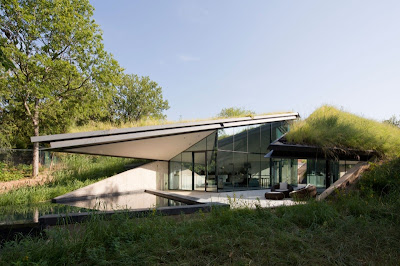Proving that everything old is new again, we have Edgeland House, a modern re‐interpretation of one of the oldest housing types in North America, the Native American Pit House. The Pit House is usually sunken into the ground to take advantage of the earth’s mass to maintain thermal comfort throughout the year.
Like that timeless dwelling, Edgeland House's relationship to the landscape, both in terms of approach as well as building performance, involves an insulative green roof and a 7‐foot excavation--gaining benefits from the earth’s mass to help it stay cooler in the summer and warmer in the winter. Such an architectural setting presents an opportunity for maximum energy efficiency when combined with high performance systems such as the integrated hydronic HVAC system. The mechanical system combines: hydronic heating and a green roof for maximum energy efficiency.
In other words, it's all kinds of green, from the roof to the floors.
Edgeland House is about healing the land and ameliorating the scars of the site’s industrial past; the home is built on a rehabilitated brownfield site. The project raises awareness about a diminishing natural landscape and its finite resources by creating a balance between the surrounding industrial zone and the natural river residing on opposite side of the site.
Both visually and functionally, the Edgeland House touches on architecture as both an art installation and an extension of the landscape. The home is broken up into two separate pavilions, one for the living and one for the sleeping quarters, and requires direct contact with the outside elements to pass from one to the other. This project sets new standards for sustainability while providing great aesthetic qualities through its small footprint and integrated mechanical features.
The only downside would be having to weed the roof every so often.
source
Wednesday, March 20, 2013
Architecture Wednesday: Edgeland House
Posted on 1:00 PM by Unknown
Subscribe to:
Post Comments (Atom)






























0 comments:
Post a Comment